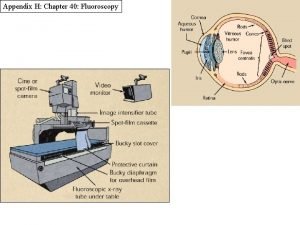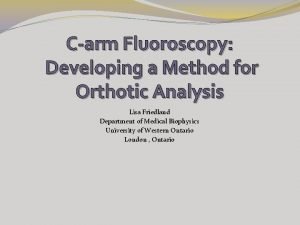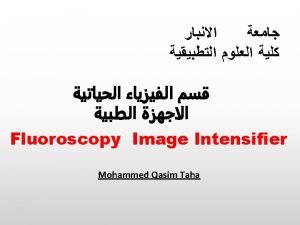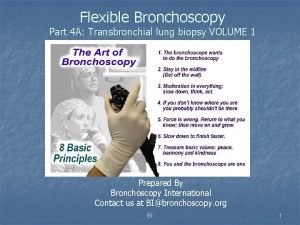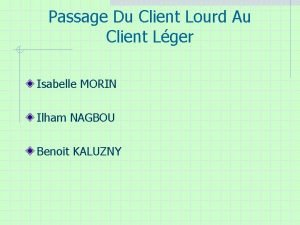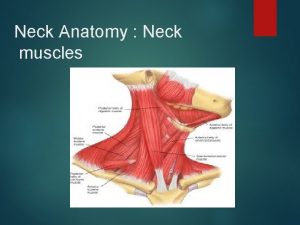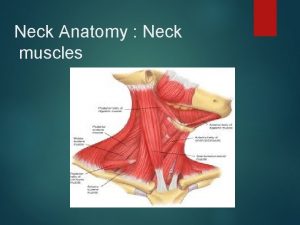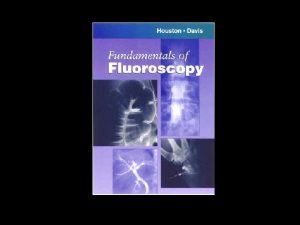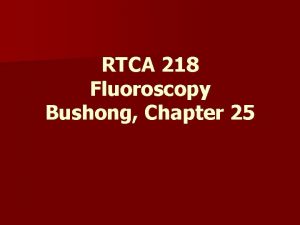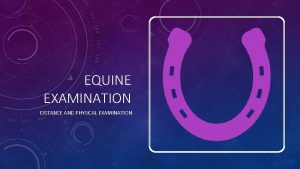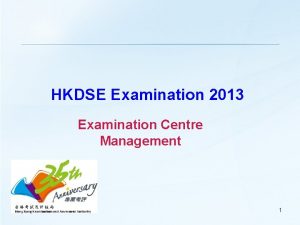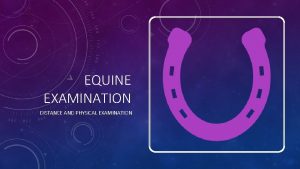Neck ExtenderFlexor for Fluoroscopy Examination Client Victor Haughton















- Slides: 15

Neck Extender/Flexor for Fluoroscopy Examination Client: Victor Haughton, M. D. Advisor: Naomi Chesler, Ph. D. Alison Boumeester Vidhya Raju Susan Samreth Peter Strohm 2/5/2022 1

Overview • • • 2/5/2022 Problem Statement Background Information Product Design Specifications Design Alternatives Decision Matrix Future Work 2

Problem Statement • Create neck positioner for use in fluoroscopy • Accommodate comatose patient http: //www. massgeneralimaging. org http: //www. medi-fax. com 2/5/2022 3

Background Information • Cervical Spine – Determine disk health through neck movement • Fluoroscopy – X-ray imaging in motion – Metal not desirable in imaging areas • Non-motorized device created Spring 2006 2/5/2022 http: //homepages. cae. wisc. edu/~bme 402/ neck_positioner_s 06/ 4

Product Design Specifications • Must not induce neck injuries • Motorized to prevent human error • Simulate natural neck movement • Extension/flexion to 45˚ from neutral • Rate of rotation 1˚/sec • Remote control operation 2/5/2022 Neck Extension www. rad. washington. edu Neck Flexion 5

Motor & Gear Design • Bi-directional motor runs minor gear • Minor gear rotates planetary gear guide • Extension/ flexion centered about axis 2/5/2022 6

Motor & Gear Design Pros Cons • Easy assembly • • No obstruction for lateral imaging • • Achieves desired range of rotation • Realistic (anatomic) • center of rotation • • Components beneath table Gear must always support head board Limited potential for expanding rotation range Awkward shape Mechanically complex 2/5/2022 7

Gear Actuator Design • Motorized worm gear controls shaft elevation • Pins stabilize shaft, prevent rotation • Head board supported by roller guide 2/5/2022 8

Gear Actuator Design Pros Cons • Easy assembly • Frame limits lower • No obstruction for rotation range lateral imaging • Possible interference • Achieves desired range • Mechanically complex of rotation • Realistic (anatomic) center of rotation • Components beneath table 2/5/2022 9

Linear Actuator Design • S-shaped board on table • Movement from actuator • Speed of rotation altered by adjusting voltage – power supply – AC to DC signal conversion 2/5/2022 10

Linear Actuator Design Pros • Easily constructed • No obstruction of lateral imaging • Achieves desired range of motion • Easily powered 2/5/2022 Cons • Moments will occur at base of actuator • Base of actuator much lower than table • Rotational rate will vary 11

Design Matrix Criteria Gear and Motor Safety 30 25 27 22 Feasibility 40 39 20 25 Aesthetics 10 6 6 9 Mechanics 20 16 15 15 100 86 68 71 Totals 2/5/2022 Linear Worm Weights Actuator Gear 12

Future Work • Research linear actuators/power supplies – How to modify linear actuators • Research materials that will not interfere with radiographic imaging – How to machine these materials • Prototype design 2/5/2022 13

Acknowledgements • Professor Block, Department of Biomedical Engineering • Professor Fronczak, Department of Mechanical Engineering • Professor Ranallo, Department of Radiology 2/5/2022 14

Questions? 2/5/2022 15
 Digital fluoroscopy vs conventional fluoroscopy
Digital fluoroscopy vs conventional fluoroscopy Tara haughton
Tara haughton Spot film device
Spot film device Carm fluoroscopy
Carm fluoroscopy Optical coupling in fluoroscopy
Optical coupling in fluoroscopy Bronchoscopy with fluoroscopy
Bronchoscopy with fluoroscopy Example of two tier architecture
Example of two tier architecture Vmatrix server manager
Vmatrix server manager Client lourd vs client léger
Client lourd vs client léger Datorkunskap för nybörjare
Datorkunskap för nybörjare Fredsgudinna
Fredsgudinna Ellika andolf
Ellika andolf Steg för steg rita
Steg för steg rita Ministerstyre för och nackdelar
Ministerstyre för och nackdelar Tack för att ni lyssnade bild
Tack för att ni lyssnade bild Claes martinsson
Claes martinsson


